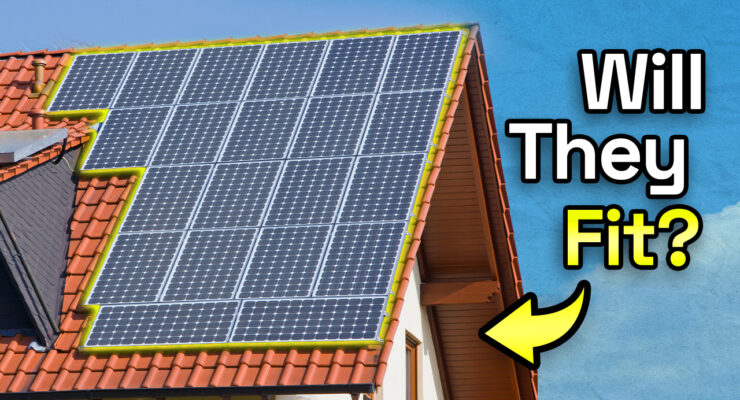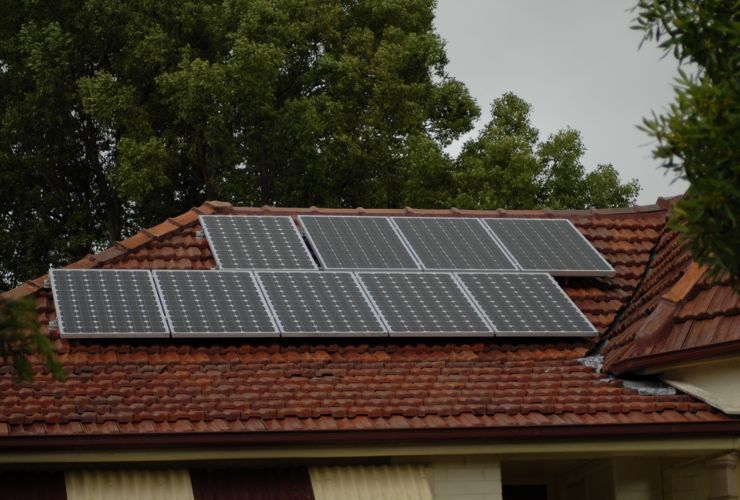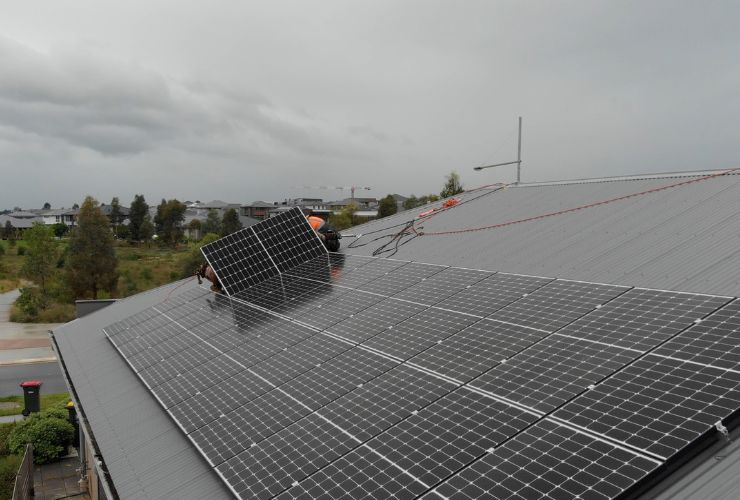
Fast read
To determine the size of your solar system, you should consider several factors. These factors include the panel size, wattage, roof angle, orientation, and available space on your roof.
The wind load on your roof should also be taken into account. Leave 200–400 mm between the gutter and the top ridge. You can multiply the number of solar panels on your roof by their wattage, usually around 400 watts.
How many solar panels will I be able to fit on my roof?
Residential roof space at home is getting more valuable as it will hold future engines to power your smart home. The question may arise ‘ How many solar panels can I fit on my roof?’ for a 6.6kW solar system. The answer can differ by a few square meters based on the panel model and roof corner angles you select.
Rooftop solar power systems have multiple solar modules linked together to form one sizeable photovoltaic generator. When you connect solar panels together, they should all be the same model, with the same wattage and size.
In the past, around 2006, solar panels had lower wattage, usually between 167 and 175 Watts. These panels were relatively compact, standing about one and a half meters tall and roughly 80 centimetres wide. These panels in Sydney produce 1,575 watts and generate around 6.3 kWh per day. They contribute to about 30% of daily energy usage.
The earlier panels were small and light, weighing around 12 to 15 kilograms. Their lightweight nature made them easier to transport and install on rooftops, contributing to the flexibility of installations. Moreover, their smaller size enabled them to be more adaptable, which made them suitable for smaller roofs where space might be limited.
In terms of space utilisation, these panels occupied approximately 1.2 square meters. The small size of the product made it easy to install on different roofs. It also allowed for flexible positioning and arrangement. This flexibility made it suitable for various home layouts and architectural limitations.
Solar panels have gotten better and more powerful, so now you can buy larger ones and have a larger system. Newer panels generate more energy, but they are larger and heavier. This can pose a problem for homes with small roofs or specific style preferences.

The new generation
In 2011 – 2012, a new generation of panels was brought to the market. These solar panels were more extensive and had more wattage, usually 250W. They were typically 1.6m high × 0.95 cm wide, meaning they took up approx 1.5 m2 and weighed 18 to 20 kg.
Today the average solar panel has dimensions of around 1.8m in height and 1.10 m wide, with outputs ranging from 370 to 420 watts. The weight is now always over 20 kg and as heavy as 24kg per panel. Also, they are making it harder for one person to bring the panel onto a roof using a ladder. The roof area one needs per solar panel is about 2 square meters.
So if you know the available roof space, you can work out approximately how many solar panels you will fit. To account for wind, there should be 200-400 mm of space between the gutter and the top ridge of the roof. This is shown in the image below.
The wind load is much higher, close to the gutter and at the roof’s gable, so avoid going right to the edge in case of severe storms.
What should you be looking out for?
When considering solar arrays, the orientation of your panels plays a crucial role in harnessing sunlight efficiently. South-facing panels tend to receive the most direct sunlight throughout the day, making them highly productive. East and west panels can also produce energy, but with slight differences because of the changing sunlight angle.
To determine how many panels can fit on various sections of your roof, measure the space on each side. This includes the east, west, and north sides. You can use 2m by 1m squares or any other measuring method to do this. By calculating the area, you can estimate the total number of panels that can be accommodated in each section.
To get an idea of the maximum solar system size your roof can support, multiply the number of panels in each section by an average output per panel, such as 400 Watts. This calculation provides an estimate of the potential energy generation capacity of your roof space.
Optimising solar panel placement not only maximises energy production but also contributes to significant upfront cost savings and reduced environmental impact.

Example of a required solar energy system
The roof has 21 m2 facing West, 21 m2 facing East, and 42 m2 facing North in a particular sample. About 33% of the roof cannot accommodate a 2m x 1m solar panel due to its angle. Therefore the number of panels that can go East is 7, West is 7, and North is 14.
The total of 28 panels will allow 28 x 400W = 11,200 Watts. So the maximum size solar system that will fit on the sample roof will be 11,2 kW. If located in Melbourne such a system, using the Your Energy Output Calculator, you will see that such a system without shade will generate 15,000 kWh per year and, on average, 41 kWh per day.
Installing solar panels has become more difficult. This is because they no longer fit properly in certain areas of the roof where they previously fit. In contrast, an older style smaller solar panel could have.
So how many solar panels will fit?
Absolutely, the dynamics between solar panel manufacturers and installers have undergone shifts, causing some discontent within the industry. Manufacturers saving money has unintentionally affected solar installers, who are important stakeholders in the industry.
Focusing on saving money may have caused problems for installers by ignoring their needs and concerns. Installers may face challenges with compatibility, installation ease, and practical concerns when installing systems.
Consumers should be careful with solar panels claiming high wattages like 500W or more, as there are many available. Relying solely on advertised wattage might not provide an accurate representation of a panel’s overall performance. The stated power may not always be the same as the actual power produced in real-life situations. This is because there are factors such as environment, efficiency, and setup that can affect the power output.
These powerful panels are made for big commercial solar systems, where their size and weight are easier to handle and acceptable. However, on residential rooftops, their size and appearance might not be as appealing. They can look somewhat unsightly and might not seamlessly integrate with the aesthetics of a typical residential setting.
It’s essential for consumers to consider various factors beyond just the claimed wattage when making a purchase decision. Consider efficiency, durability, warranty, compatibility, and aesthetics when choosing to ensure it aligns with energy goals and looks good.


